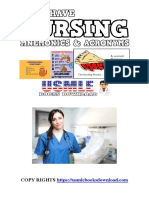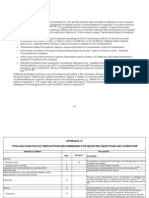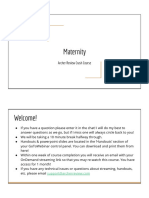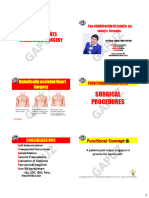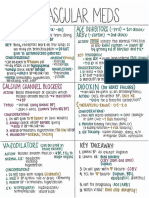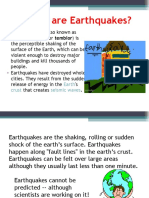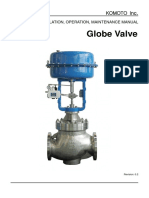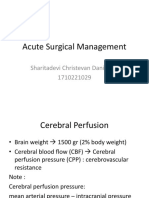Super Cram Sheet - PDF Version 1
Super Cram Sheet - PDF Version 1
Uploaded by
Jan MitchelleCopyright:
Available Formats
Super Cram Sheet - PDF Version 1
Super Cram Sheet - PDF Version 1
Uploaded by
Jan MitchelleOriginal Title
Copyright
Available Formats
Share this document
Did you find this document useful?
Is this content inappropriate?
Copyright:
Available Formats
Super Cram Sheet - PDF Version 1
Super Cram Sheet - PDF Version 1
Uploaded by
Jan MitchelleCopyright:
Available Formats
1. Scene Size-up 3A. Rapid Focused P. E. and History 3B. Rapid Focused P. E. and History 3C.
3B. Rapid Focused P. E. and History 3C. Detailed physical 4. Baseline Vitals
a. Body (MEDICAL) Signs
Substance (TRAUMA) a. Rapid focused physical exam examination a. Pulse
Isolation a. Rapid focused physical exam (using DCAPBLS-TIC-PMS) a. Head b. Ventilations
b. Is my scene safe (using DCAPBLS-TIC-PMS) (1) Head b. Face c. Blood pressure
c. Mechanism of injury (1) Head (2) Neck c. Ears d. Skin color and
Nature of illness (2) Neck (3) Chest d. Eyes temperature
d. # of patients (3) Chest (4) Pelvis e. Nose e. Level of
e. Call for help (4) Pelvis (5) Abdomen (TRDG) f. Mouth consciousness
f. Begin Triage (5) Abdomen (TRDG) (6) Extremities g. Neck (AVPU)/LOC Level
2. Initial Assessment Tenderness Rigidity Distension Guarding (7) Back h. Chest 1. Person
(6) Extremities (8) Baseline vitals i. Abdomen 2. Place
Use a General Impression (7) Back Evaluate chief complaint (OPQRST) j. Pelvis 3. Time
to Assess the patients (8) Baseline vitals (1) Onset k. Extremities 4. Event
Position/Signs/Activity Signs of Trauma (DCAPBLS-TIC-PMS) (2) Provocation l. Back f. Pupil Reaction
“Hey, Hey are you okay” (1) Deformities (3) Quality m. Reassessment of g. SAMPLE History
(1) Alert (2) Contusions (4) Radiation Baseline vitals (Reassess vitals
(2) Verbal stimulus (3) Abrasions (5) Severity every 5 minutes for
(3) Painful Stimulus (4) Punctures/Penetrations/Paradoxial Mvmnt (6) Time Trauma every 15
(4) Unresponsive (5) Burns b. Rapid focused history (SAMPLE) minutes for other)
TAKE CSPINE (6) Lacerations (1) Signs
(ABCDEF) (8) Swelling (2) Allergies
a. Airway assessment (9) Tenderness (3) Medications
b. Breathing assessment (10) Instability (4) Pertinent medical history
Look/Listen/Feel (11) Crepitus (5) Last oral intake ABBREVIATIONS/MEANINGS
c. Circulation assessment (12) Pulses (6) Event AMI Acute Myocardial Infarction
d. Determine Patient Priority (13) Motor response ASHD Ateriosclerotic Heart Disease
(14) Sensory ROOT WORDS/MEANINGS BP Blood Pressure
e. Expose the patient
f. Focused exam CARDI Heart C Centigrade
b. Rapid focused history (SAMPLE) OSTE Bone CA Cancer
(1) Signs GASTR Stomach CCU Cardiac Care Unit
(2) Allergies NEPHR Kidney CHF Congestive Heart Failure
PCR Pre-hospital Care 4
(3) Medications PHLEB Vein COPD Chronic obstructive Pulminary Disease
Report CSF Cerebrospinal Fluid
(4) Pertinent medical history TRACHE Trachea
PPE CVA Cerebrovascular Accident
(5) Last oral intake THORAC Chest
Personal Protective DX Diagnosis
(6) Events leading to
ON-GOING injury/Illness
ASSESSMENT PREFIXES/MEANINGS
Equipment ECG Electrocardiogram
LOC Level of Further evalinitial
1. Repeat chiefexam
complaint (OPQRST) AMBI Both, Both Sides
F Fahrenheit
2. Vital signs PRE Before, In Front
Consciousness FX Fracture
3. Recheck what was found during focused exam HYPO Under, below
PTSD Post Traumatic GI Gastrointestinal
Stress Disorder 4. Recheck interventions EPI Upon
GM Gram
OSHA Occupational Safety INTER Between ICU Intensive Care Unit
and Health Secure the Airway POST After, Behind IV Intravenous
Administration SUFFIXES/MEANINGS O2 OXYGEN
DABDA Denial Anger Barganing Heat Conservation in the Body -ECTOMY Exicion RN REGISTERED NURSE
Depression Acceptance Oxygenation of RBCs -IT IS Inflammation RX Treatment
CISD Critical Incident Stress Core perfusion improved by elevation of legs CENTESIS Surgical Puncture P- Pulse
Debriefing Keep the field time short -METER Instrument to Measure R- Respiration
PEARL Pupils Equal And React -SCOPY Visual Exam
to Light -PARESIS Partial Paralysis
Compensated – Hypoperfusion/Hypoxia starts – compensated by reduced container
constricted blood flow increased respitory rate increased force of heart contractions TYPES: Hypovolemic: low volume Cardiogenic: pump failure Psychogenic: emotional Septic: infections
Uncompensated – Decreased perfusion of organs – no longer maintains normal BP ext time cells die Anaphylactic: allergic reaction
COMMON DIRECTIONAL TERMINOLOGY SKELETON
TORSO Trunk of the body The chest is located in the TORSO CARTLIDGE between bones lubricate and cushion
MIDLINE Line vertically down the middle The nose is located in the MIDLINE LIGAMENTS hold bones together
MEDIAL Toward the midline The heart is MEDIAL to the right arm 206Bones divided into eight parts
LATERAL Away from the middle The ear are located LATERAL to the head JOINTS
PROXIMAL Closer to the trunk The elbow is PROXIMAL to the trunk Ball and Socket, Hinged, Pivot, Fused/Sutured
DISTAL Farther from the trunk The wrist is DISTAL to the elbow Ellipsoid, Saddle, Plane/Gliding Joints connect bone to bone
SUPERIOR Above The head is SUPERIOR to the shoulders SKULL (4 major areas
INFERIOR Below The feet are INFERIOR to the knees Frontal Occipital Temporal Parietal
MIDAUXILLARY Line down mid armpit to ankle Divides body into anterior and posterior BONES of the FACE (5 major bones)
ANTERIOR Toward the front The abdomen is located ANTERIOR to the spine Nasal 2 Maxilla 2 Zygomatic Mandible Orbit
POSTERIOR Toward the rear The spinal column is located POSTERIOR to the heart SPINAL COLUMN
MIDCLAVICULAR Line down clavicle to pelvis The nipples are located in the MIDCLAVICULAR line 33 bones called vertebrae
BILATERAL Pertaining to both sides The patient had BILATERAL wrist deformities 7 Cervical, 12 Thoracic, 5 Lumbar, 5 Sacrum, 4 Coccyx
DORSAL Toward the back The buttocks are located on the DORSAL side of body THORAX
VENTRAL Toward the front The abdomen is located on the VENTRAL side of body 12 Ribs attached posteriorly to thoracic vertibre
Of 12 only 10 attached anteriorly to the Sternum
PALMAR Relating to the palm The patient had a PALMAR wart
PLANTAR Relating to sole of the foot The patient had a PLANTAR wart Sternum divided into 3 parts Manubrium, Body, Xiphoid Process
PELVIS
PRONE Lying face down The patient was found PRONE
Iliac Crest, Ishium, Pubis
SUPINE Lying face up The patient was found SUPINE
UPPER EXTREMITIES
FOWLER position Sitting up The patient was placed in the FOWLER position
Shoulder blade (3 parts) Scapula, Acromoin, Clavicle, Humerus, Ulna, Radial
TRENDELENBURG pos Feet up, head down The patient was placed in the TRENDELBERG position
Carpals, Metacarpals, Phalanges
RECOVERY position On side
LOWER EXTREMITIES
ASPICES Plural of APEX The uppermost portion of the liver is the APEX
Femur Hip Joint Patella Tibia Fibula
INTEGUMENTARY SYSTEM Ankle (Medial and Lateral Malleolus)
2 Divisions, Foot (Tarsals and Metatarsals)
The Central Nervous System (CNS) composed of Brain and Spinal column Largest organ of the body
CARDIOVASCULAR
Command center of the body Brain = Brain Stem, Cerebellum (big), Cerebrum (little) Protects the body from environment
3 components/ Heart, Blood, Blood vessels (Pump, Pipes, Fluid)
The Peripheral Nervous System (PNS) composed of 2 types of nerves, Sensory and Motor 3 Layers
Two circuits, Pulmonary (Lungs) and Systemic (Body)
Sensory nerves (carry messages from body to CNS) Epidermis
Heart made of 3 layers, Epicardium, Myocardium, Endocardium
Motor nerves (carry messages from CNS to body) Dermis
Pericardium is the thin sack or layer around the heart
Autonomic nervous system carries out voluntary and involuntary actions Subcutaneous
Arteries flow away from the heart/Veins flow to the heart
Sympathetic nervous system, speeds up heart rate
Aorta, Arteries, Arterioles, Capillaries, Venules, Veins Vena Cava S/I
Parasympathetic slows down heart rate
MUSCULAR SYSTEM Artery: Aorta, Coranary, Carotid, Femoral, Brachial, Radial, Iliac, Pedis, Tibial,
Muscles divided into 3 types Mouth, Nose, Oropharynx Veins: Vena cava S/I, Iliac, Femoral, Great saphenous
DIGESTIVE SYSTEM Voluntary Nasopharynx 4 Heart Valves, Tricuspid, Pulmonary, Mitral, Aortic
Processes solids and liquids Contract/Relax at will Pharynx, Epiglottis Larynx, Vocal Pulmonary arteries- take waste blood to the lungs
Transcends oral, thoracic, abdominal, and pelvic cavaties Tendons connect bone to cords Pulmonary veins- bring O2 rich blood to the heart
Food taken into mouth, esophagus, stomach, small intestine, muscle creating pull when Trachea, Carina Blood composed of plasma and three types of cells
Large intestine, colon, rectum the muscle contracts Bronchi, Bronchioles Plasma, suspends the blood cells and nutrients(45% blood fluid)
Striaped Alveolus Red cells (erythrocytes) contain hemoglobin (binds O2 to tissue
Extension (muscle relaxes) Lungs 3 lobes right/ 2 left White cells (Leukocytes) (fights infection)(5 types)
Flexion (muscle contracts) Diaphragm Platelets (thrombocytes)(clots blood)(damaged red cells)
Involuntary Visceral Pleura, lung ext Adult has 5-6 liters of blood (5000ml) Infants 800 ml, Newborn 300ml
Secretes chemicals called hormones from glands into Smooth muscles Parital Pleura, chest wall Blood pressure, Adult normal is 120/80 with females normally 10 lower
bloodstream Cardiac Intercostal mucles, between ribs Systolic (left ventricle contracts) high #
The hormones regulate body activities and functions Found in heart (smooth) Ventilation Diastolic (left ventricle rests) low #
Two major hormones are epinephrine(adrenalin) and insulin 12-20 adult Perfusion circulation of blood through organ/structure
Insulin is produced by the pancreas and metabolizes Generates own contraction 15-30 child Heart pumps out of blood/cycles blood in about 1 minute /called Cardiac Output
glucose for energy Has 3 layers 25-30/50 infant Radial most used pulse, Carotid easiest to find, check Rhythm, Character, Rate
Epicardium (outer) Measure – Rhythm: Intervals between beats, regular/irregular
BODY CAVATIES Myocardium ( mid contracts) Rate/Rhythm/Quality/Depth Character : Full=Strong, Bounding=Extremely Strong, Thready = Weak, Rapid
Skull Cavity, Thoracic Cavaty Endocardium (inner) Mediastinum, cavity behind lungs Pulse Rate: Adult=60–100 / Child=80–100 / Infant=100–140 Newborn=130-140
Abdominal Cavity/divided into four quadrants Tidal Volume = 500ml is normal Tachycardia = high pulse >100 Bradycardia = low pulse <60
You might also like
- NCLEX PharmacologyDocument51 pagesNCLEX PharmacologyJan Mitchelle100% (7)
- 2 Months Nclex Study CalendarDocument2 pages2 Months Nclex Study CalendarJan Mitchelle67% (3)
- Must Have Nursing Mnemonics PDFDocument50 pagesMust Have Nursing Mnemonics PDFJanus Lazaro100% (2)
- ABG InterpretationDocument7 pagesABG Interpretationpaulzilicous.artNo ratings yet
- Hurst BurnsDocument4 pagesHurst BurnsKristin Jones100% (5)
- Nclex MedsssDocument6 pagesNclex MedsssSheryl_13No ratings yet
- Nclex - Mnemonics - Slides - PDF Version 1Document98 pagesNclex - Mnemonics - Slides - PDF Version 1Jan Mitchelle100% (5)
- Homonyms, Homographs, HomophonesDocument2 pagesHomonyms, Homographs, HomophonesVimala Thevy100% (1)
- Aikido Success BlueprintDocument0 pagesAikido Success Blueprinttroc.icfoNo ratings yet
- Nursing Cheat SheetDocument1 pageNursing Cheat Sheetramesh kumarNo ratings yet
- GastrointestinalDocument23 pagesGastrointestinalArvee Caezar F. VizcarraNo ratings yet
- Gastrointestinal: Nclex-Rn ReviewerDocument34 pagesGastrointestinal: Nclex-Rn ReviewerJohnasse Sebastian NavalNo ratings yet
- Critical CareDocument25 pagesCritical Carejassen karylle IbanezNo ratings yet
- Saunders Study PlanDocument1 pageSaunders Study PlanLudmilla MartinsNo ratings yet
- Endocrine System: Disorders Assessment Nursing Interventions Diabetes InsipidusDocument27 pagesEndocrine System: Disorders Assessment Nursing Interventions Diabetes InsipidusDulle Mullet100% (1)
- Safety and PrecautionDocument36 pagesSafety and Precautionpaulzilicous.artNo ratings yet
- Mark K Lecture #2Document16 pagesMark K Lecture #2Melissa Sapp100% (2)
- Nclexrnteststudyguide PDFDocument199 pagesNclexrnteststudyguide PDFLids70No ratings yet
- Hurst Review CDC Infection Control ChartDocument44 pagesHurst Review CDC Infection Control ChartTerry Thun100% (2)
- MaternityDocument52 pagesMaternityeliNo ratings yet
- Basic Care and ComfortDocument35 pagesBasic Care and ComfortRebecca TapiaNo ratings yet
- NCLEX Pharmacology Antidotes Cheat Sheet - NCLEX QuizDocument1 pageNCLEX Pharmacology Antidotes Cheat Sheet - NCLEX QuizGlen GeddaNo ratings yet
- Day 7 SlidesDocument53 pagesDay 7 SlidesHudson OnsareNo ratings yet
- NCLEX Medication ListDocument18 pagesNCLEX Medication Listnpopal098No ratings yet
- Ms Flash CardsDocument15 pagesMs Flash CardsMia MalazoNo ratings yet
- Pediatric Nursing Flashcards2 - QuizletDocument50 pagesPediatric Nursing Flashcards2 - QuizletNursyNurseNo ratings yet
- Common Diseases in NCLEXDocument15 pagesCommon Diseases in NCLEXdecsag06No ratings yet
- NCLEXstudyguidevmDocument31 pagesNCLEXstudyguidevmAnonymous vqG0paWG100% (1)
- NCLEX Nurse BundleDocument109 pagesNCLEX Nurse BundleVishma PathakNo ratings yet
- Endocrine 10-Day Post Live ModulesDocument15 pagesEndocrine 10-Day Post Live ModulesPascal St Peter Nwaorgu100% (2)
- Nclex 3500Document4 pagesNclex 3500chitor100% (1)
- RespiratoryDocument42 pagesRespiratorytiraray30No ratings yet
- PVD-PAD Simple NursingDocument3 pagesPVD-PAD Simple NursingJerica Mae VenoyaNo ratings yet
- Med SurgDocument9 pagesMed SurgVanessaMUeller100% (1)
- ISBAR Worksheet Olivia Jones Jasgou1752Document1 pageISBAR Worksheet Olivia Jones Jasgou1752Jasmyn Rose100% (1)
- Cardiology & Ekgs: Archer Nclex ReviewDocument59 pagesCardiology & Ekgs: Archer Nclex Reviewdaphne farley100% (1)
- PedsDocument41 pagesPedsrunnermn100% (2)
- RN Plan StudyDocument13 pagesRN Plan Studywestlake12100% (1)
- Brain Dump NUR 213 FINALDocument37 pagesBrain Dump NUR 213 FINALkelsey jackson100% (1)
- DelegationDocument8 pagesDelegationpaulzilicous.artNo ratings yet
- NCLEX Study MaterialDocument40 pagesNCLEX Study MaterialChristie GerconNo ratings yet
- Strategy DefinitionsDocument8 pagesStrategy DefinitionskwameNo ratings yet
- Dosage CalculationDocument11 pagesDosage Calculationpaulzilicous.artNo ratings yet
- Precautions NclexDocument1 pagePrecautions NclexAngelo Karzovic100% (1)
- 1 - Yellow BookDocument49 pages1 - Yellow Booksushma.rayamajhi.bsc06No ratings yet
- Archer 1Document577 pagesArcher 1gracesheeba1985No ratings yet
- Step 1: Identify The TopicDocument1 pageStep 1: Identify The TopicRonny Andres CarrascoNo ratings yet
- ATI Psych ProctoredDocument6 pagesATI Psych Proctoredyoderjess425No ratings yet
- Kaplan Nclex ReviewDocument13 pagesKaplan Nclex ReviewOlgaKNo ratings yet
- Cardiovascular Summary Saunders Comprehensive Review For The Nclex RN ExaminationDocument40 pagesCardiovascular Summary Saunders Comprehensive Review For The Nclex RN ExaminationdanicaNo ratings yet
- NCLEX Quick FactsDocument7 pagesNCLEX Quick FactsMary Aurine FullanteNo ratings yet
- NCLEX Updates June 2010Document21 pagesNCLEX Updates June 2010erika_datu100% (1)
- All Uworld Notes 2019 Page4 Nclex NotesDocument152 pagesAll Uworld Notes 2019 Page4 Nclex Notesedithamadasu100% (1)
- Line and TubesDocument18 pagesLine and Tubespaulzilicous.artNo ratings yet
- Bullets Nclex Terms 50Document48 pagesBullets Nclex Terms 50ShazaNo ratings yet
- UWorld Critical CareDocument14 pagesUWorld Critical CareJohnasse Sebastian NavalNo ratings yet
- Fluids and ElectrolytesDocument9 pagesFluids and Electrolytespaulzilicous.artNo ratings yet
- 13 2023 Surgery Revised HandoutsDocument26 pages13 2023 Surgery Revised HandoutswesamNo ratings yet
- Nclex GuideDocument3 pagesNclex Guidemichegirl91No ratings yet
- MedicationsDocument27 pagesMedicationsThe Treasure ChestNo ratings yet
- Labor and DeliveryDocument56 pagesLabor and DeliveryeliNo ratings yet
- Diets and NutritionDocument47 pagesDiets and NutritionArvee Caezar F. Vizcarra100% (1)
- NCLEX-RN Exam Prep 2024-2025: 500 NCLEX-RN Test Prep Questions and Answers with ExplanationsFrom EverandNCLEX-RN Exam Prep 2024-2025: 500 NCLEX-RN Test Prep Questions and Answers with ExplanationsNo ratings yet
- How to Succeed New Graduate Nursing Job Interview & Bachelor of Nursing Clinical Placement?From EverandHow to Succeed New Graduate Nursing Job Interview & Bachelor of Nursing Clinical Placement?No ratings yet
- Practice 2Document1 pagePractice 2Jan MitchelleNo ratings yet
- Practice 1Document1 pagePractice 1Jan MitchelleNo ratings yet
- LPG Storage Tank Fire and ExplosionDocument7 pagesLPG Storage Tank Fire and ExplosionULISESNo ratings yet
- Lambou Delto PectoralDocument9 pagesLambou Delto PectoralalexNo ratings yet
- Triage in Polytauma: Prof. Dr. A. Chandrasekaran M.S., PH.D.Document73 pagesTriage in Polytauma: Prof. Dr. A. Chandrasekaran M.S., PH.D.ShrutiNo ratings yet
- The Carlson Group v. Davenport (Injunction Opinion)Document17 pagesThe Carlson Group v. Davenport (Injunction Opinion)Ken VankoNo ratings yet
- Dissection Guide On The Frog Muscular SystemDocument6 pagesDissection Guide On The Frog Muscular SystemNeileene Joy Simeon DomingoNo ratings yet
- Kral CK Screw Pump Range EnglishDocument40 pagesKral CK Screw Pump Range Englishnikunj8170No ratings yet
- Dela Torre Vs ImbuidoDocument5 pagesDela Torre Vs Imbuidohmn_scribdNo ratings yet
- Example Risk Assessment For An Office-Based BusinessDocument5 pagesExample Risk Assessment For An Office-Based Businessphelo1No ratings yet
- Pedestrians-Pedacyclists AccidentsDocument54 pagesPedestrians-Pedacyclists AccidentsJohanna Ferebee StillNo ratings yet
- Morisaki 2021Document4 pagesMorisaki 2021Deborah SalinasNo ratings yet
- On EarthquakeDocument27 pagesOn EarthquakeSaurav KapilNo ratings yet
- Black and Decker-Pv9605nDocument76 pagesBlack and Decker-Pv9605nararyanNo ratings yet
- KMT - GLOBE - Manual (Ver0.2) - Eng - 16-2026 (2016.08.16)Document21 pagesKMT - GLOBE - Manual (Ver0.2) - Eng - 16-2026 (2016.08.16)Ozi Fawzi100% (1)
- Installation, Operation and Maintenance of Airflex@ CM Marine ClutchDocument12 pagesInstallation, Operation and Maintenance of Airflex@ CM Marine Clutchaiyubi2No ratings yet
- Rune BearerDocument247 pagesRune BearerDavidNo ratings yet
- HeelDocument4 pagesHeelDoha EbedNo ratings yet
- Nomenklatur IBS Edit THTDocument291 pagesNomenklatur IBS Edit THTriezki_pattikratonMDNo ratings yet
- Trauma Thorax - Dr. Darmawan Ismail, SP - BTKV (K)Document33 pagesTrauma Thorax - Dr. Darmawan Ismail, SP - BTKV (K)Josafat PondangNo ratings yet
- ORAL and MAXILLOFACIAL TRAUMA - Dental Ebook & Lecture Notes PDF Download (Studynama - Com - India's Biggest Website For BDS Study Material Downloads)Document17 pagesORAL and MAXILLOFACIAL TRAUMA - Dental Ebook & Lecture Notes PDF Download (Studynama - Com - India's Biggest Website For BDS Study Material Downloads)Vinnie SinghNo ratings yet
- TractionDocument14 pagesTractionRukshana Balakrishnan100% (2)
- Acute Surgical Management: Sharitadevi Christevan Daniswari 1710221029Document26 pagesAcute Surgical Management: Sharitadevi Christevan Daniswari 1710221029daaaniiisNo ratings yet
- Hârnmaster Advanced Combat Tables: Weapon Comparison TableDocument3 pagesHârnmaster Advanced Combat Tables: Weapon Comparison TableOscar Smith100% (1)
- Clinical Assessment of The Musculoskeletal System: A Guide For Medical Students and Healthcare ProfessionalsDocument40 pagesClinical Assessment of The Musculoskeletal System: A Guide For Medical Students and Healthcare ProfessionalsChristine Joy Molina100% (1)
- Herman D. Coloma For Petitioner. Glicerio S. Ferrer For Private RespondentsDocument5 pagesHerman D. Coloma For Petitioner. Glicerio S. Ferrer For Private RespondentsMichelle CosicoNo ratings yet
- Ulna (Bone and Attachments) Flow ChartDocument3 pagesUlna (Bone and Attachments) Flow ChartLove GuruNo ratings yet
- Muscle Up GuideDocument18 pagesMuscle Up GuideKodreanu23100% (5)
- Anatomi Blok 5Document5 pagesAnatomi Blok 5dfghjk lkjhgNo ratings yet
- 800 Questions PDFDocument256 pages800 Questions PDFDrBhawna Arora100% (1)


